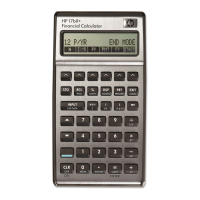64 5: Time Value of Money
File name : English-M02-1-040308(Print).doc Print data : 2004/3/9
Table 5-1. TVM Menu Labels (Continued)
Menu Label Description
Second Level (Continued)
Sets Begin mode: payments occur at the beginning of
each period. Typical for savings plans and leasing.
(The Begin and End modes do not matter if PMT=0.)
Sets End mode: payments occur at the end of each
period. Typical for loans and investments.
Accesses the amortization menu. See page 78.
The calculator retains the values of the TVM variables until you clear
them by pressing
@c
. When you see the first-level TVM menu,
pressing
@c
clears N, I%YR, PV, PMT, and FV.
When the second-level menu ( ) is displayed, pressing
@c
resets the payment conditions to
.
To see what value is currently stored in a variable, press
R
menu
label. This shows you the value without recalculating it.
Cash Flow Diagrams and Signs of Numbers
It is helpful to illustrate TVM calculations with cash-flow diagrams.
Cash-flow diagrams are time lines divided into equal segments called
compounding (or payment) periods. Arrows show the occurrence of
cash flows (payments in or out). Money received is a positive number
(arrow up) and money paid out is a negative number (arrow down).
The correct sign (positive or negative) for TVM numbers is
essential. The calculations will make sense only if you
consistently show payments out as negative and payments in
Note

